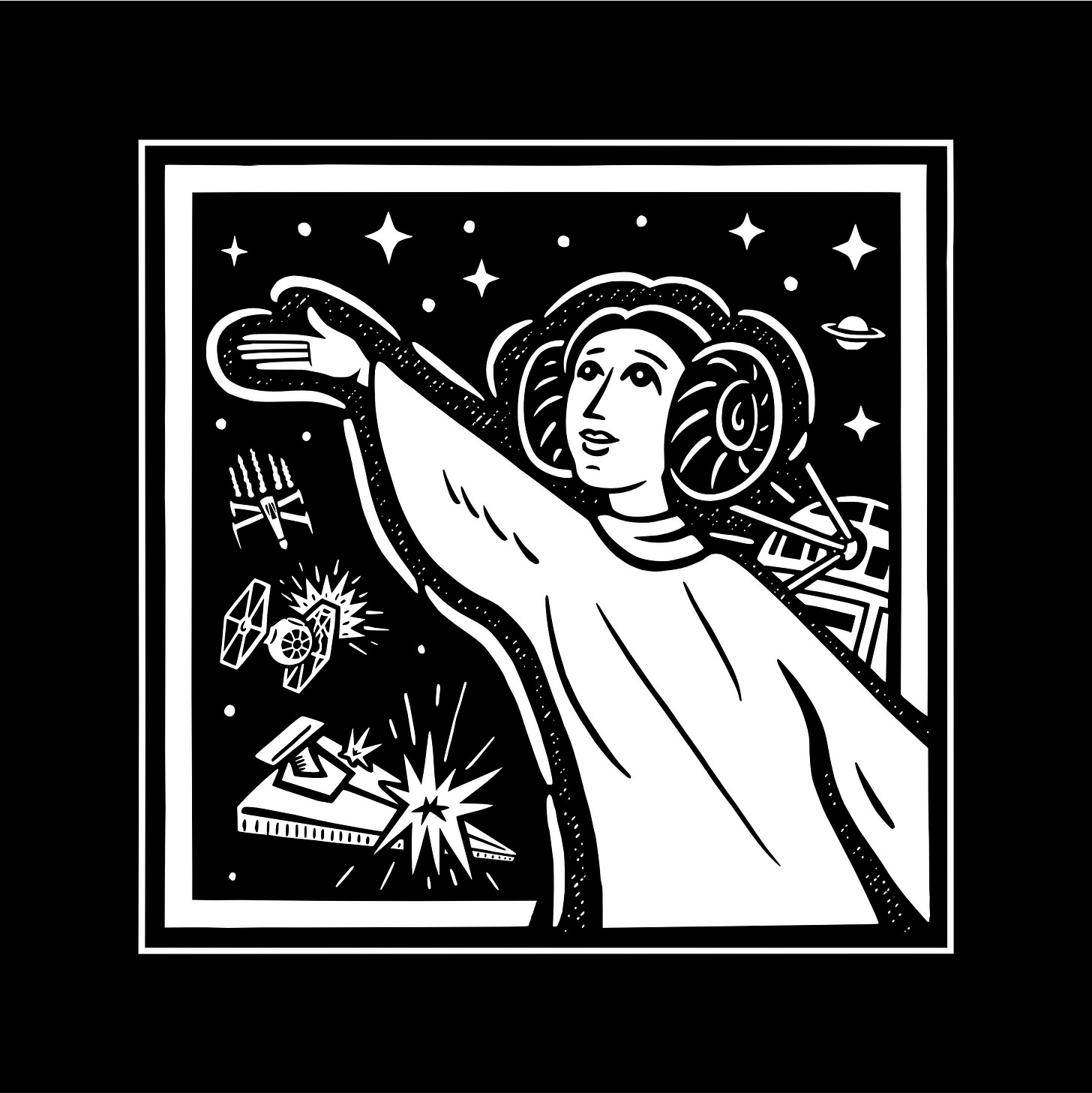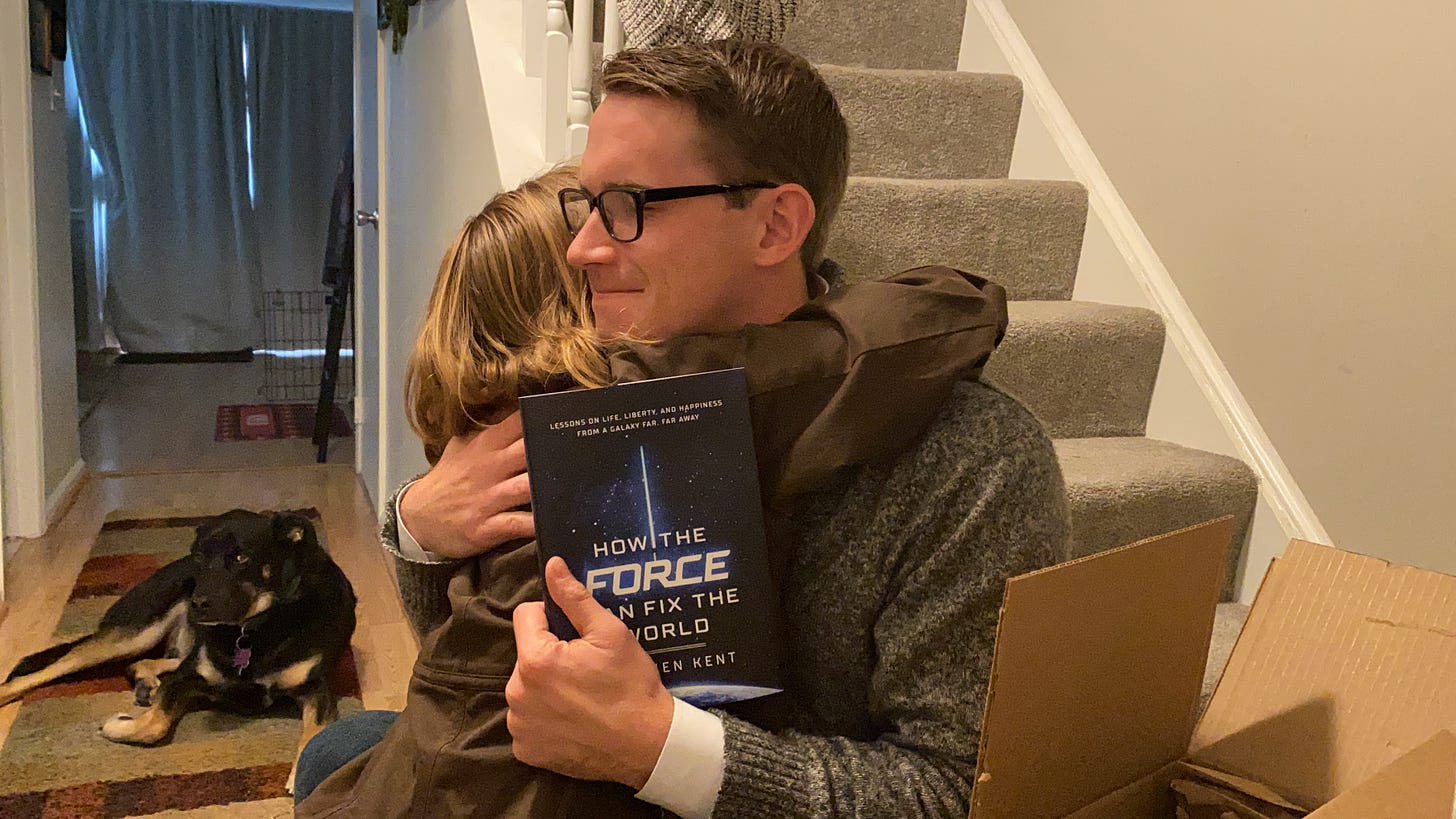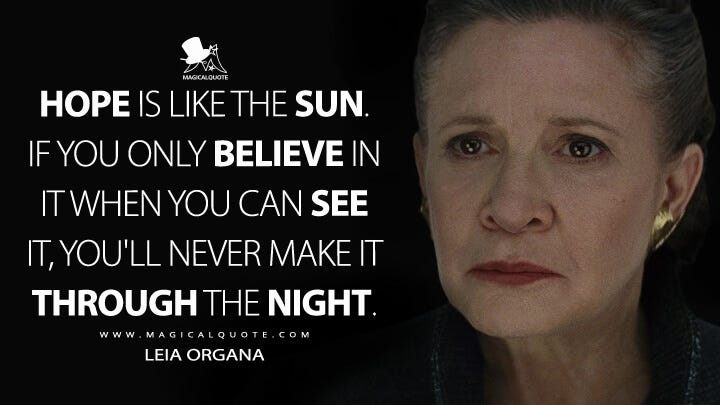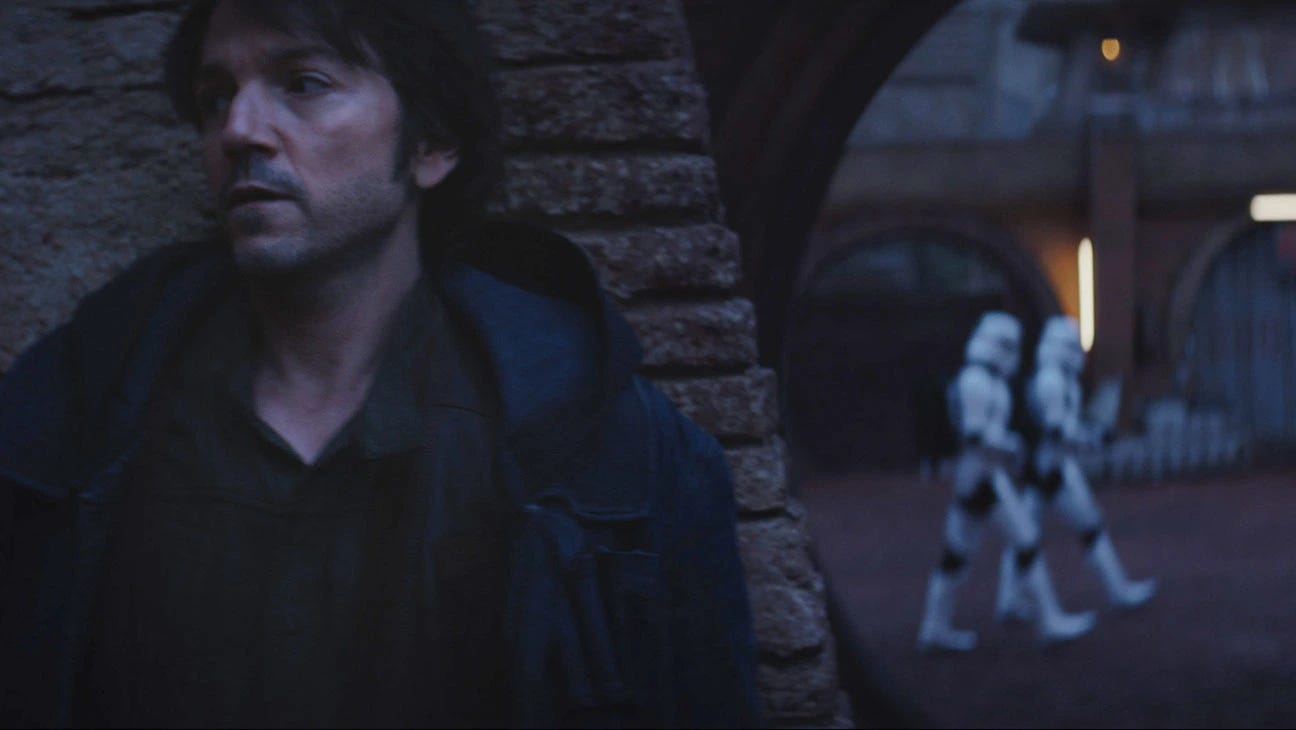Are your politics rooted in hope or fear?
Part 1: The journey to Star Wars' Andor & the formation of a rebellion
Andor is quickly approaching! This new series from Star Wars on Disney+ is a spinoff of the fan-favorite, Rogue One: A Star Wars Story (2016) which took us behind the scenes of the Rebel plan to steal to the blueprints of the Death Star. This was an amazing movie detailing how an impossible mission was actually fulfilled. It changed the course of galactic history and lit a flame of hope in a galaxy doused in fear by the despotic Empire. This was the moment the Rebellion had been waiting, fighting, and dying for. Andor is going to show us how and why Cassian Andor, one of the Rebels of Rogue One, decided to join the fight. It’s going to be a very political show by nature. Some will moan and groan about this, but it truly can’t be avoided with this kind of story. And why would we want it to be avoided? Star Wars (1977) spoke to us all about evil and mustering up the will to challenge it. This is what our love of the Force is all about.
To prime you for Andor, I want to share with you the chapter titled Hope, from my 2021 book, How The Force Can Fix The World. In it, I chart how hope & fear interact with our real-world political dramas and why Star Wars’ enduring message of hope can show us the way toward being better citizens, neighbors and friends. I’ll do this in three parts over the next week, in about 10-minute segments. Let’s begin.
HOPE IS LIKE THE SUN, IF YOU BELIEVE IN IT WHEN YOU CAN SEE IT, YOU’LL NEVER MAKE IT THROUGH THE NIGHT.
“This is never going to end,” my daughter cried just a few days from Christmas of 2020. Her head rested on my shoulder and I could feel her tears starting to seep through my shirt. This went on for some time, all because I had the bright idea of asking her if she was excited about the coming new year. She was not. I can’t blame her.
I’ve never experienced something like the Coronavirus pandemic in my life. What Bill Gates called a “once-in-a-century pathogen” in February 2020 shaped up to be exactly that by years end — a seismic force that changed the world as we knew it. In the week between Christmas and New Years Eve 2020, the U.S. death toll surpassed 330,000 with roughly 1.75 dead worldwide. No industry or sector of the economy was immune from the effects of the virus and subsequent government actions (and overreactions) to slow its spread. Millions of jobs were lost. Small businesses everywhere closed their doors in the first wave of government imposed lockdowns, only to never reopen after modest assistance was given by Congress in the form of direct cash aid and business loans. Schools closed, forcing children across America into “distance learning” and classes via Zoom, a worthy experiment but one that proved disastrous for educational outcomes and the mental health of children, parents and teachers.
When did you first feel hopeless in 2020? I have yet to speak with someone who survived that no good, awful year who said they never felt a moment of weakness, despair or hopelessness about the pandemic. And I want to emphasize “survived,” because it hit close to home for over half of Americans. Pew Research found that 54% of Americans knew someone who’d been hospitalized or died from COVID-19. For me it was in the first week of November that I felt the stabbing pain of hopelessness. A line was wrapping around my local Costco with people loading up on paper products and sanitizer as fears of a second COVID wave were crystallizing alongside anxieties regarding the presidential election. It felt for a time as if this was really it, this was going to be life from now on. Masking up. Social distancing. Elbow bumps instead of hand shakes. Polite nods instead of warm hugs.
With this crying child on me and my mind racing to find “perfect Dad-like wisdom” to try and lift her up from this moment of despair, I began to cycle through the pop-culture encyclopedia in my brain for something to say to her. Because let’s be honest, there’s nothing I could say to her that she could count on. Our governor could reimpose lockdowns and business closures the next day on a whim, and Dr. Anthony Fauci could change his mind again about the merit of reopening schools.
“Do you have hope?” I asked her.
“Yeah, but-”
I continued, “Hope is like the sun. If you only believe in it when you see it, you’ll never make it through the night.”
She paused and closed her eyes. Letting one more tear slide down her cheek as she thought it over. She knew the line. My nicely timed Star Wars reference to a quote delivered by Admiral Holdo (Laura Dern) in Episode VIII: The Last Jedi. Holdo, a towering and proud, wiry framed woman with purple hair, offered this wisdom to the brash “flyboy”, Poe Dameron (Oscar Isaac), to try and assuage his doubts about how the Resistance would escape the First Order, whose Star Destroyers and legion of Stormtroopers were bearing down on them. The situation was what you might call — hopeless. Holdo and Dameron both held these words in high regard, because they were those of Princess Leia, or General Organa as she’s known at this point in her career.
Hope really is like the sun. It warms us, it guides us and it helps to fill our worlds with color. But the sun can also become lost behind clouds and shrouded in impossible darkness, with no clear end to that gray haze in sight. If you don’t know that the sun is in fact there, or believe it will eventually emerge from those clouds, you really will struggle to make it to that next warm day.
We need hope. You’re gonna learn about why hope matters, how you can cultivate it and what to do when hope feels out of your reach. No matter where you stand in your politics, left or right, you might notice there are always forces calling you toward either your better angels or your most guttural impulses. Are your leaders offering you hope and inspiring you? Or are they selling cynicism, fear and doubt?
When it comes to social movements, revolutions (or rebellions), hope is the ingredient that so often can make or break them. We’re going to look at some movements driving conversation in the United States and determine if they’re driven by hope.
Like the Rebel Alliance who faced down an impossibly powerful Empire, we too have a choice to make in how we talk about and shape the future. Will we be a people who wallow in despair and nihilism, gratifying our primal urges as the world falls apart....or will we do the hard work of building the kind of world we want to see?
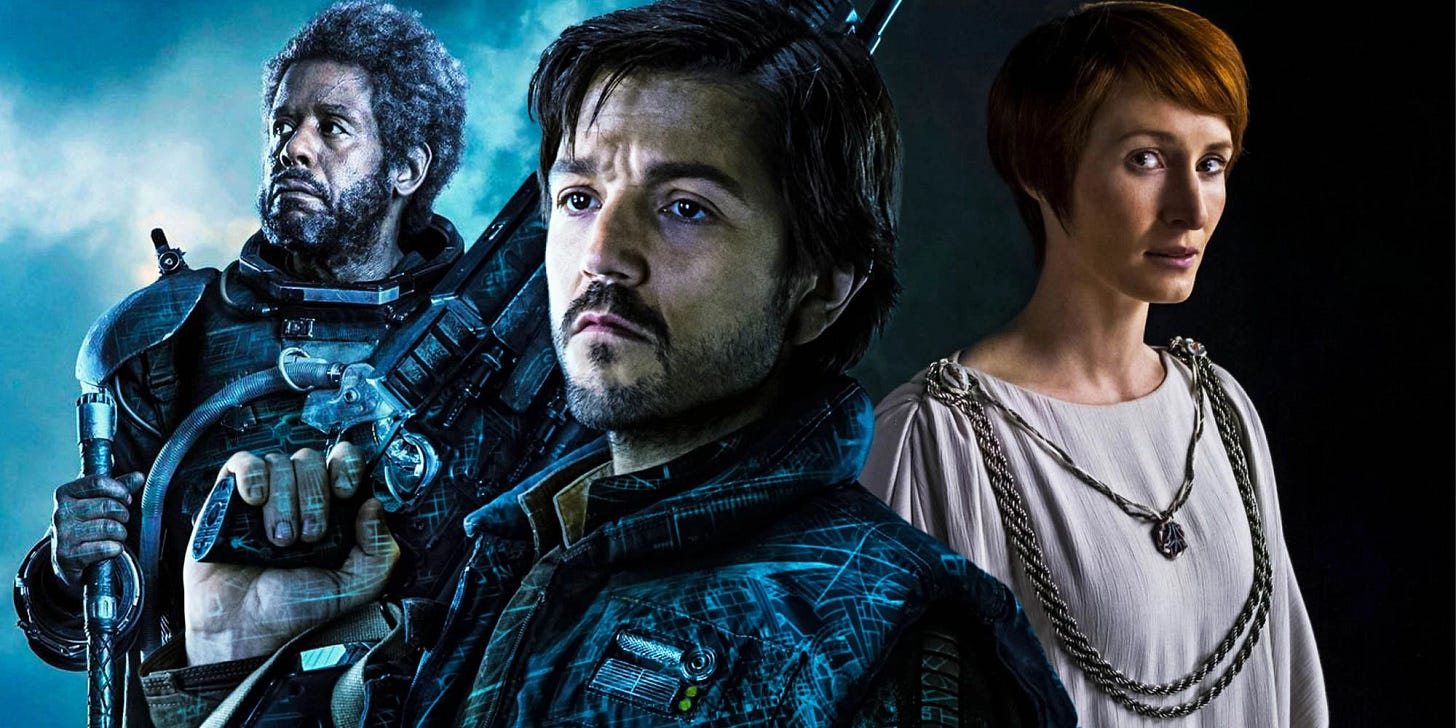
Leia’s impossible hope
Grand Moff Wilhuff Tarkin was never going to spare Alderaan. When Princess Leia misled him about the location of the Rebel Base in Episode IV: A New Hope (1977), naming the mostly desolate world of Dantooine as the location of the base, Tarkin had already planned a murderous demonstration of the Death Star’s power for all the galaxy to see. Alderaan was Leia’s home. Her parents and fellow rebels, Bail and Breha Organa, were on the planet at the time Tarkin gave the order for the massive orbital space station to fire on the planet. Millions upon millions of lives were snuffed out in an instant. The Death Star, which the Rebellion had risked everything to stop, was now fully operational. Tarkin, whose belief in the Death Star was rooted in the cynical goal of solidifying the Empire’s hold on power through absolute fear, had made his move and put all his chips on that belief.
He was wrong. I’ve always marveled watching A New Hope and taking note of the poise and resoluteness of Princess Leia throughout that original Star Wars film. While Luke Skywalker is a beacon of hope to audiences in his own way, Leia strikes me as unique. After escaping the Death Star with Luke, Han Solo and Chewbacca, it’s Leia who comforts Luke for his loss of Obi-Wan Kenobi. He looks shattered. Leia on the other hand, having just lost everything in the most literal sense, remains motivated as ever. She has the eye of the tiger from start to finish.
How the heck does she do it?
What our future vision says about us
We’ve been living through some seriously dark days for mankind. Between repeated economic downturns and a global pandemic the likes of which haven’t seen since the Spanish Flu of 1918, things have felt pretty darn awful. Millions died worldwide from the Coronavirus, and if you were in the United States you had a 50/50 chance of personally knowing someone hospitalized or killed by the virus. It’s not a surprise that mental health professionals are seeing an unprecedented spike in anxiety, depression and suicides across multiple age groups and demographics. Political systems were already straining before the pandemic even began. Populist movements and authoritarian leaders have risen across the globe and chipped away at the democratic consensus that has defined the post-World War II order. In the U.S., political violence has flared to levels not seen since the tumultuous 1960’s.
In 2020 we saw a summer of protests spurred on by racially tinged instances of police brutality, protests that quickly spiraled into weeks of major cities burning, businesses being looted and street violence of all sorts. Progressive groups like Black Lives Matter and the black clad militants of Antifa defined much of the media discussion and debates being had around dinner tables in those dramatic months. That is, until the incident of January 6th, 2021, when far-right demonstrators gathered in Washington D.C. to protest the counting and certification of Electoral College votes for Joe Biden. At the behest of President Donald Trump, the crowd morphed into a mob and descended on Congress, breaking into the Capitol and ransacking the closest thing we have to a sanctuary for democracy. The business of government was halted only for a few hours, the votes were counted and certified, but by the end at least 4 people were dead, including one Capitol police officer. Donald Trump became the first president to ever be impeached more than once by Congress as a result of what happened.
Something is changing. Storm clouds are gathering.
I don’t know about you but I did not have a pandemic, nationwide riots and attack on Congress written on my 2020 Bingo card. This isn’t the future I dreamed of. Maybe you grew up believing mankind would be in space by now, living like The Jetsons or even blasting through hyperspace like Han Solo aboard the Millennium Falcon to new and exciting worlds. It can be kind of demoralizing. We thought we’d have flying cars, but instead, all we got was curbside pickup at Starbucks.
It’s easy to forget that things are getting better all around us in ways that are hard to see. Since I was born in 1989, income per person in the United States has risen 67% — life expectancy is up 4% and food supply has increased by 7%. When my father was just a boy, mankind was putting its feet on the Moon for the first time, today we’re making huge strides toward manned missions to Mars. Heck, the robotic rovers we’ve sent to Mars in recent years have uncovered proof that there used to be water on that distant red planet. Once the question was, is there life out there in the stars? Now we’ve moved on to a new question — where is that life?
You know that scene in Episode IV: A New Hope, with Luke Skywalker standing in the desert at dusk, watching the twin suns of Tatooine set on the horizon? It’s one of the most enduring moments of Star Wars from generation to generation. The lonely dreamer looking out on the world and believing there must be more to it than what they can see. Luke is all of us at that moment. It doesn’t matter if you’re Elon Musk, risking a fortune on a new space shuttle to make it to Mars, or you’re a young girl living in the cramped Chicago apartment with five siblings and dreaming of making it big in Hollywood...lifting your family out of poverty in the process.
Maybe you call this hope. Maybe you call it the “American Dream.” These things go hand in hand. Do you have hope?
Hope beyond hope
“Hope” is a lot of things. In our minds it can be personified, objectified or embodied in places, faith and prose. But it does have a definition. Merriam Webster’s Dictionary defines hope as: to cherish a desire with anticipation — to want something to happen. Or to: desire accompanied by expectation of or belief in fulfillment.
In short, it’s to want something you can (in theory) actually have. I want very badly to have the Jedi power of levitating objects and moving them around my house with my mind, but I don’t have hope of achieving such a thing, nor should I. It’s not within the realm of possibility. But what if I watched enough YouTube videos made by weirdos living in their mothers basements, telling me beyond the shadow of a doubt that I’m wrong, and this power is in fact attainable? All I’d have to do, according to these armchair wizards of the web, is watch enough of their videos and wire them some money. There’s a good chance at some point, you’ll become bitter and angry. Afterall, someone sold you false goods, hope beyond hope.
This is what happens to Anakin Skywalker when he is told by a supposed friend, Chancellor Palpatine, about the power to control life and death that is known only to the Sith. Anakin, suffering from visions of his wife dying in childbirth, is lured in by a twisted kind of hope we might understand as an intergalactic spin on the trope of the snake oil salesman who travels from town to town hocking miracle cures that almost certainly will let the buyer down.
Just as hope can push the likes of Princess Leia forward through a tragedy like the destruction of Alderaan, hope can also move a desperate and loving husband to spend the last of his savings or sell the house to get that cure from the roving snake oil salesman. There is a light and dark side to everything.
In the Christian tradition, hope sits alongside faith and charity as core virtues of the religion and its guiding lights. The notion that God would send his Son to mankind in order to deliver them from sin and by extension, damnation, is a damn good dose of hope for a people in need of redemption. Absent that guiding light and the possibility of salvation, you’d have masses of people mired in endless cycles of guilt and despair.
Hope here is more than a feeling. It’s not something that washes over you and leaves like an emotion (ie: anger, fear, sadness). No. As a virtue, it’s something you discover and hold onto for dear life, despite everything the world will throw at you. Hope is the life vest. Hope is the parachute when you’ve jumped out of a plane. It’s like faith. You can become a person who is hopeful (and positive) or you can become cynical, someone who is predisposed to see the worst in people and in the future.
Even worse, absent hope you can devolve into a thing called nihilism, a particularly toxic kind of hopelessness rooted in the belief that nothing matters. Most people aren’t born this way. It’s a learned behavior and one increasingly popular with young people and lauded throughout our popular and political culture.
Throughout Star Wars, audiences understand rightly that the Empire is an incredibly evil and morally bankrupt regime. With this being crystal clear, would-be rebels have a choice to make in how they make their stand against the Empire. It’s not good enough to simply oppose the Empire. To win the Rebel Alliance has to do three things — First, let the people of the galaxy know they’re not alone in feeling angry about the state of things. Second, let people know that the Empire can actually be beaten. Third, paint a picture of the future and offer to the people what it is they’re fighting for that goes beyond the regime they seek to dismantle.
The Rebel Alliance does all of these things. In our own world, the majority of successful movements and political campaigns do as well.



